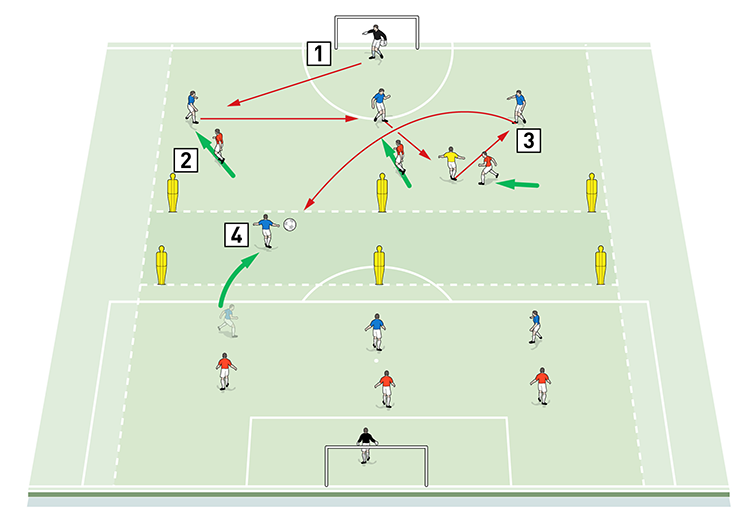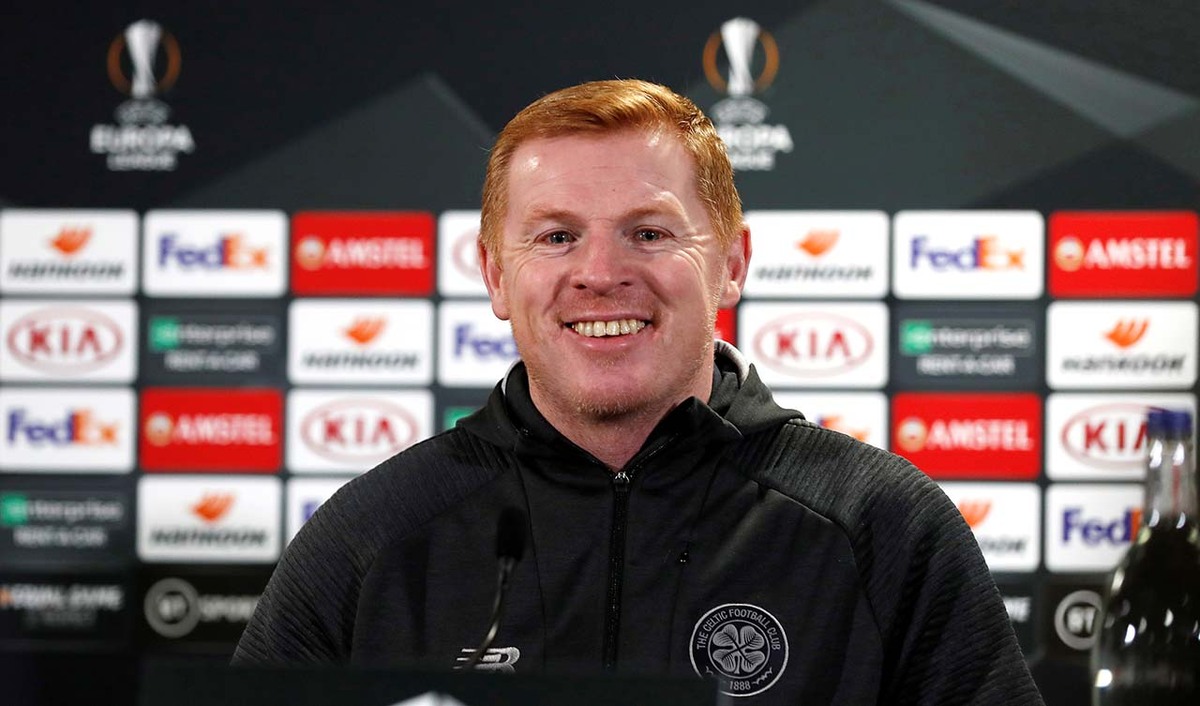You are viewing 1 of your 1 free articles
Build up and attack with overloads
This training session allows us to focus on attacking play with overloads. It also helps us to work on positional play and how to progress the ball into areas where the team can create chances and score goals. It helps players understand how to make the most of an overload and attack the goal with speed.
| Area | Up to half a pitch |
| Equipment | Balls, bibs, cones, mannequins, 2 goals |
| No. of Players | Up to 13 players + 2 goalkeepers |
| Session Time |
Attacking 3v2: 15mins, Build up and attack: 20mins |
This training session allows us to focus on attacking play with overloads. It also helps us to work on positional play and how to progress the ball into areas where the team can create chances and score goals. It helps players understand how to make the most of an overload and attack the goal with speed.
We like this session because it’s very relevant to our game model as we want to take advantage of counter-attacking situations and be able to play through pressure. When the press has been eliminated, we want to accelerate our attacks and make the most of the opportunities we have created.
These activities will keep the players fully engaged with the session as they call for a lot of actions, good decision making and a heavy focus on attacking play. This is all in keeping with our style of play at Celtic.
We would tend to revisit this session fairly regularly as it draws out moments which are very representative of those that we encounter in a real game, such as 3v2 and 4v3 situations.
ATTACKING 3v2
We set up an area of 36x40 yards with a goal and a goalkeeper at one end. We’re using 10 outfield players split into an attacking team of six and a defending team of four. Three attackers and two defenders are active for each pair of attacks, while the remaining players wait for their turn to rotate in after two balls.
The attackers are set up with a winger on each flank and a striker on the edge of the penalty area. They are going up against two central defenders.
Play starts each time with a pass from the coach, who varies which attacking player receives the ball. If the first attack starts with a pass to the striker and if the supporting wingers make runs that draw the defenders wide, then the striker can turn and attack the goal, as shown [1a].
1a

2. Here the first attack starts with a pass from the coach to the striker
3. The supporting wingers make runs that draw the red defenders wide
4. The striker now has the space to turn and attack the goal
If the striker receives the starting ball from the coach and passes out to a winger, then the striker should then continue his forward run and end up in a position close to goal to meet a cross or pick up a potential rebound, as shown [1b].
1b

2. The winger receives the pass and either crosses into the goalmouth or shoots at goal
3. After passing the striker continues his forward run and ends up in a position close to goal to meet a cross or pick up a rebound
However, if the first attack starts with a pass to a winger who drives forward with the ball, the striker should make a central run while ensuring that he stays onside. The other winger would support play on the far side, giving the ball carrier passing and crossing options. The winger should either cutback for the striker to finish, as shown [1c], or cross to the opposite winger who has made a run to the back post.
1c

2. The other winger would support play on the far side, giving the ball carrier crossing options at the back post
3. The striker should make a central run and meets a cutback from the winger and shoots
The second attack is launched immediately the first attack dies out, without need for resetting the players. As the defenders aren’t set, the attackers should accelerate their attack, making quick runs and sharp movements before the two defenders can reorganise themselves, as shown [1d].
1d

2. As the red defenders aren’t given the opportunity to reset, the attackers should quickly attack before the defenders can reorganise
What are the typical mistakes players might make and how do I avoid them?
A typical mistake players make is passing the ball to the outside too quickly, allowing defenders to lock the ball carrier to the side and create 1v1 or 2v2 situations. To avoid this, we encourage players to bring the ball central and anticipate the defender committing. If they don’t commit and the attacker is close to goal, then we encourage the attacker to quickly shoot.
BUILD UP AND ATTACK
We now progress the session by transferring the attacking principles that we have just worked on into a game format involving an overload in the build-up play, before attacking the goal in another overload situation.
We set up on half a normal pitch with a goal and a goalkeeper at each end and a central zone marked out with mannequins, as shown in the diagrams.
We’re using 13 outfield players split into two teams of six and one neutral midfielder who plays for the team in possession. Both teams start with three defenders in the zone in front of the goal they are defending and three attackers in the zone in front
of the goal they are attacking.
Play always starts with a pass out from one of the goalkeepers and the possession team uses the goalkeeper and the floater to help them build up play and work the ball into the central zone, where a team mate can drop from the attacking half to receive a pass unopposed, as shown [2a].
2a

2. The red attackers press to win the ball
3. The blue possession team’s defenders use the yellow floater to help them build up play and work the ball into the central zone
4. A blue attacker drops into the unopposed central zone from the attacking half to receive a pass
The attacker who receives in the central zone must then play the ball forward to a team mate in the attacking zone and return to the zone himself. Joined by the floater who switches halves, the attackers use their overload to launch a 4v3 attack on the goal, as shown [2b]. They should use the attacking principles from the first activity to finish with a shot on goal.
2b

2. The yellow floater switches halves to give the attackers a 4v3 overload when they attack the goal
3. Here the wide attacker receives a back post cross from the opposite wide player and scores
Whether they score or not, once the attackers have fired a shot at goal the keeper immediately plays out from the back and the team that just attacked must now quickly counter-press to stop the ball being played out too easily, as shown [2c].
2c

2. The blue team that just attacked now counter-press high up the pitch to stop the ball being played out too easily
3. A red attacker drops into the central zone to make himself open for a pass when the reds are ready to launch an attack on the top goal
What are the key things to look out for?
We want to see players using good positioning in the build-up to open forward passing lanes. If the three pressers defend narrow, we want to see the possession team looking to play around the outside.
We also want to see the possession team passing with patience in the build-up to disorganise the three opposition pressers and then recognise the moment to play the ball forward. From the point the ball is played forward, we want to see the possession team accelerating the speed of the attack.
What are the typical mistakes players might make and how do I avoid them?
Players can sometimes get their positioning wrong in the build-up phase. To give the possession team control of the ball in this phase, we encourage the use of the goalkeeper as an extra player, which along with the floater would give them a 5v3 overload against their high pressing opponents. We would also discourage the defenders from coming too close to the goalkeeper, which would allow the pressing player to easily press between both players.
Another typical mistake players make is that the defenders don’t always identify the moment to eliminate the press during the build-up play. They should be patient but shouldn’t stay in the press longer than required and when a clear opportunity to eliminate the press arises, they should make the forward pass or carry the ball forwards.
How would I put this in a game situation?
After these exercises we would finish the session by playing a normal 11v11 game with the squad. We would encourage one team to be very aggressive in their pressing, whilst the other team should try to focus on positional play, breaking the press and fast attacking with overloads.
Related Files
Editor's Picks
Deep runs in the final third
Using the goalkeeper in build-up play
Pressing principles
Intensive boxes drill with goals
Penetrating the final third
Creating and finishing
My philosophy
Pressing initiation
Compact team movement
Coaches' Testimonials

Alan Pardew

Arsène Wenger

Brendan Rodgers

Carlos Carvalhal

José Mourinho

Jürgen Klopp

Pep Guardiola

Roy Hodgson

Sir Alex Ferguson

Steven Gerrard
Coaches' Testimonials

Gerald Kearney, Downtown Las Vegas Soccer Club

Paul Butler, Florida, USA

Rick Shields, Springboro, USA

Tony Green, Pierrefonds Titans, Quebec, Canada
Join the world's leading coaches and managers and discover for yourself one of the best kept secrets in coaching. No other training tool on the planet is written or read by the calibre of names you’ll find in Elite Soccer.
In a recent survey 92% of subscribers said Elite Soccer makes them more confident, 89% said it makes them a more effective coach and 91% said it makes them more inspired.
Get Monthly Inspiration
All the latest techniques and approaches
Since 2010 Elite Soccer has given subscribers exclusive insight into the training ground practices of the world’s best coaches. Published in partnership with the League Managers Association we have unparalleled access to the leading lights in the English leagues, as well as a host of international managers.
Elite Soccer exclusively features sessions written by the coaches themselves. There are no observed sessions and no sessions “in the style of”, just first-hand advice delivered direct to you from the coach.









